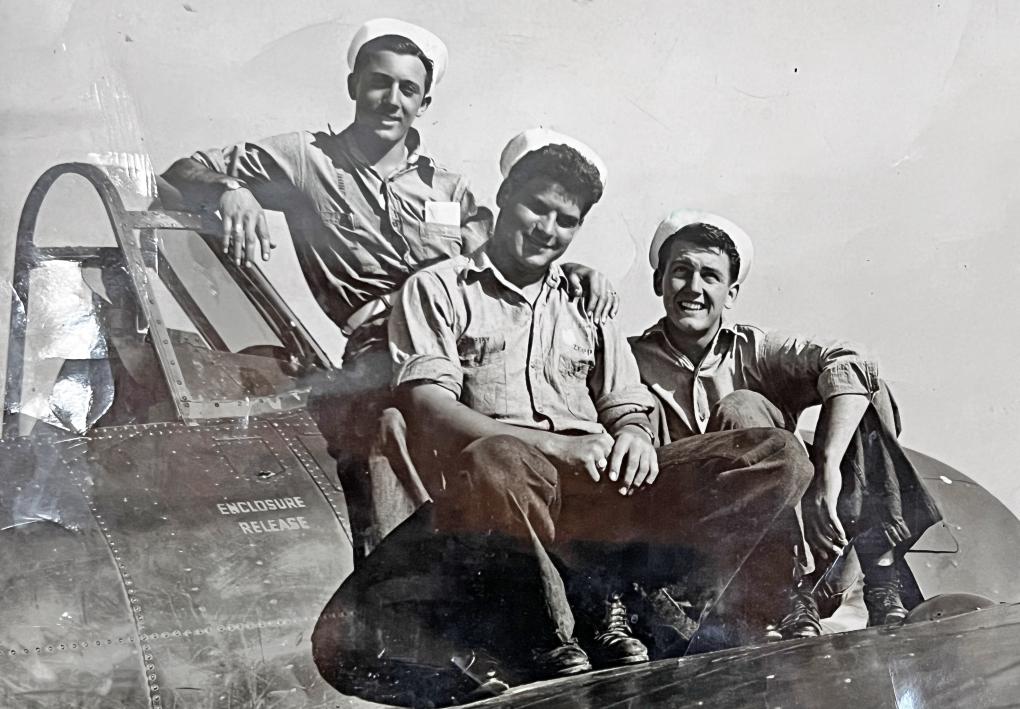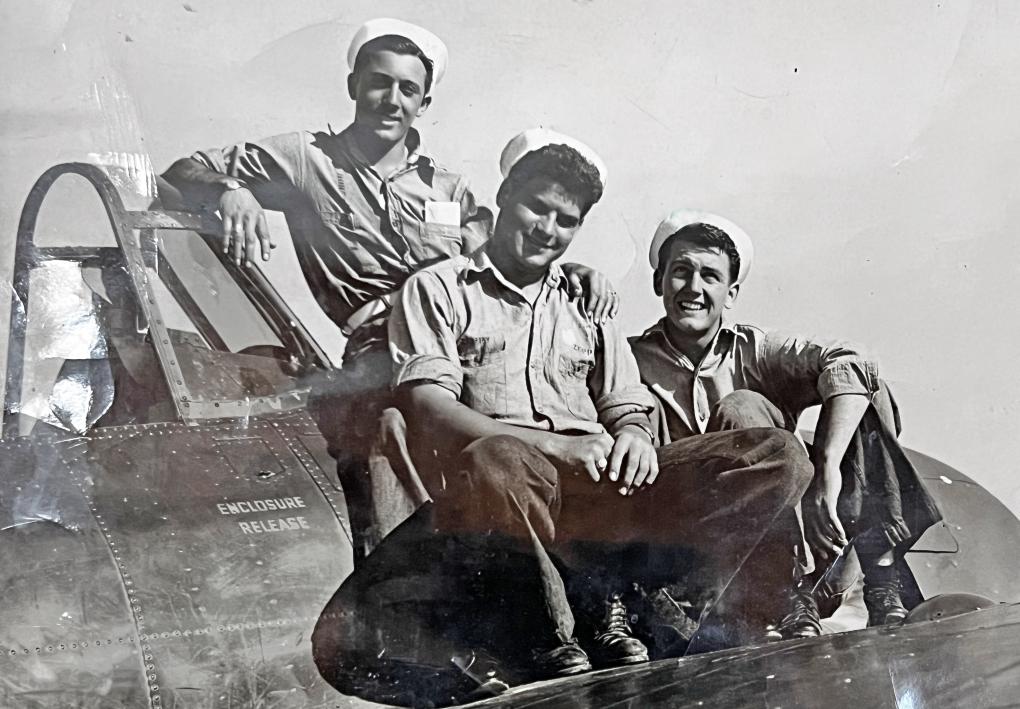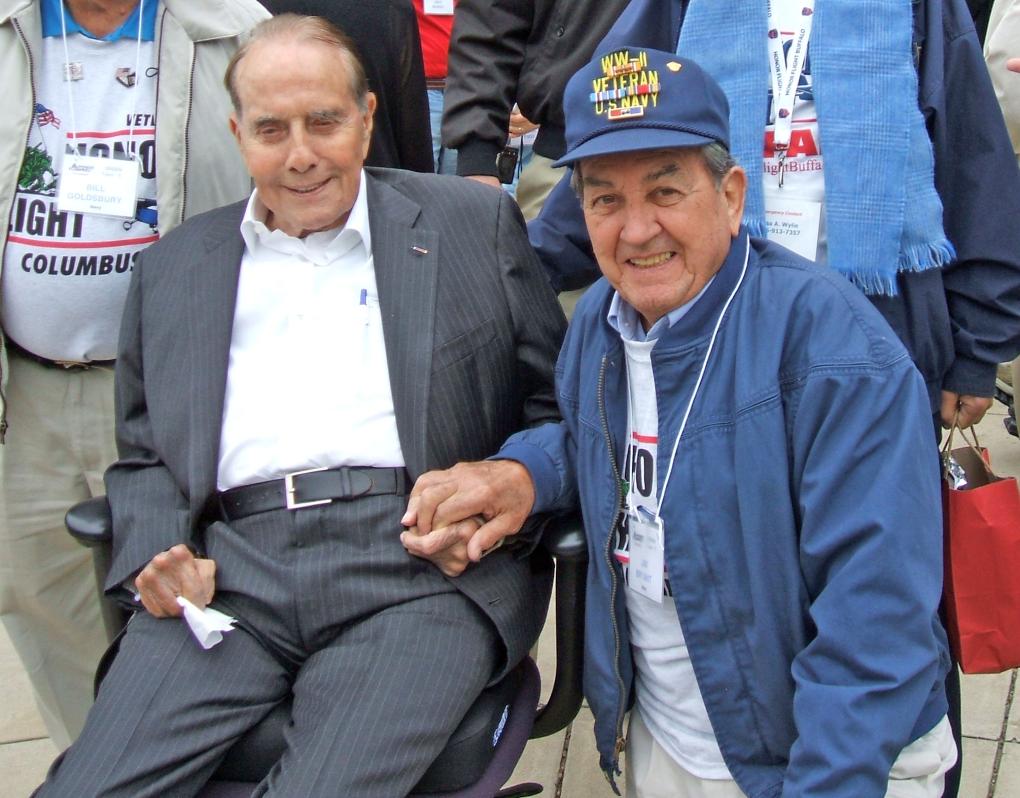Remembering WWII kamikaze attack survivor and former New Albany resident Jim Bryant’s remarkable life

A year ago, I met – by chance – one of the most amazing men. Ninety-seven-year-old James T. Bryant was a World War II veteran who served in the Navy as a flight mechanic aboard the U.S.S. Marcus Island. His stories of coming under attack by Japanese kamikazes kept me riveted. But it was his unwavering kindness – to me, to his family, to everyone he knew – that made him a hero to me. And we became friends. Jim died six days ago. But he will live in the hearts of his loved ones for many years to come. The following is excerpted from a story about Jim that I wrote for the January 2024 issue of (614).
-John M. Clark, (614) Magazine Contributor
~~~
Jim Bryant remembers the events of December 15th, 1944, as if they had happened just last month, or even last week. The World War II aircraft mechanic watched in horror as a Japanese kamikaze plane, no doubt packed with explosives, headed straight for the carrier he served on in the South Pacific. Anti-aircraft fire proved useless, and the ship’s entire crew stood a very real chance of being blown into the sea by a lone, suicidal, enemy pilot.
Then, the moment of impact. Bryant held his breath as the plane glanced off a lookout platform, instead, and crashed into the sea. The strike killed one sailor. Moments later, a second plane came into view. The second pilot barely missed the flight deck and barreled into the ocean, spraying the flight deck with shrapnel. More sailors were injured.
Seventy-nine years later, Bryant still treasures a souvenir of the twin, near-death encounters – a palm-sized hunk of twisted aircraft metal that bears a portion of the red “zero” painted on the side of one of the doomed kamikazes.
At 97 years old, James Bryant, of New Albany, Ohio, is one of a rare breed – the World War II veteran. Fewer than one-percent of the 16.1 million Americans who fought in that terrible war, 80 years ago, are still among us. And more than 200 more are lost to old age every day.
BROUGHT TO YOU BY
A stroke in early November slowed Bryant down a bit. But there’s no doubt he is a true survivor. He doesn’t need glasses or hearing aids. His memory is sharp, and so is his wit. Just before his stroke, he recalled a recent conversation with one of his doctors. “I guess I’ve almost worn out my second pacemaker battery,” he said. “And they’re talking about putting in the third one. I don’t think they see that very often.”
The gentle-spoken nonagenarian with a face that belies his age recounted his remarkable life in early fall, while sipping sweet tea from the shade of his front lawn. “I was born May the 14th, 1926, in Harlan County, Kentucky,” he said. “Coal country. My father was a mine foreman. There were seven of us children. I was the youngest. And my mother, who was pregnant at the time, died in a car accident when I was just two-and-a-half. Yeah, times were hard. And my father did the best he could.”
Bryant continued to live with his father for four or five years after his mother died and then bounced from one relative’s home to another until he was 16. Then, like most of his brothers before him, and with only 10 years of formal education, he left the impoverished valley.
“I remember taking a cardboard suitcase with my clothes in it down to the Greyhound bus station and buying a one-way ticket to Columbus,” he said. “That was 1942, and I had an older cousin here that I came to live with for a little while. I worked at a car dealership on North High Street, changing oil and that sort of thing. But my cousin’s family was growing, and more relatives were coming up from Kentucky, so I moved on. I was a restless scoundrel!”

Next stop was Cincinnati, and the home of a widowed sister. That lasted just a couple of months, until Bryant turned 17. It was 1943, and World War II was raging. Bryant, the “restless scoundrel,” wanted nothing more than to be a part of it. He recalled, “I was supposed to be 18 before I could sign myself up. Younger than that, and you had to have a parent’s OK. I didn’t want to get in by cheating, so I took a train back to Kentucky to get my father’s permission. He gave me his signature and I came back to Ohio, where I was sworn into the U. S. Navy.”
Bryant was assigned to the USS Marcus Island, a mid-sized, mass-produced escort carrier ship that traveled with about 900 men and 33 aircraft. Their mission – to support the other military branches in their assaults on Japanese strongholds in the Pacific. Each attack plane was assigned one pilot and one mechanic, also known as a plane captain.
In his two-plus years of active duty, Plane Captain James Bryant witnessed some of the heaviest fighting in the Pacific Theater. His ship’s first engagement was supporting the Marines in their fight over the tiny island nation of Palau.
“Next was Leyte Gulf,” he recalled. “We lost a lot of ships and a lot of people there. This was our first attempt to put soldiers on the ground in the Philippines.” By some estimates, the Battle of Leyte Gulf was the largest naval battle in history. It was shortly after this, during the Battle of Mindoro Island, that Bryant encountered the kamikazes. In fact, this was the very first battle in which the Japanese carried out the organized suicide missions.
Japan surrendered to Allied Forces in September 1945. In March 1946, Bryant returned to Cincinnati to care for a brother who was dying from pancreatic cancer. He paid his bills by rebuilding car engines for a local Ford dealership. And it wasn’t long before he met his future wife, Lois. The newlyweds relocated to Huntington, West Virginia, for fifteen years, where the couple raised three children. By this time, Bryant had stepped up in the business world, selling automotive test equipment throughout the region. The family moved to Columbus in 1963, so their deaf son Paul could attend the Ohio State School for the Deaf.
Eventually, in 1968, Bryant and his wife found a ranch-style house to their liking on a 28-acre tract of land in New Albany. “When we moved here,” he said, “the entire front of the property was wheat fields. We eventually built another couple of houses there, including one for Paul, but I still have plenty of land.”
In the years since the war, Bryant has lost his father, all six brothers and sisters, a granddaughter and, in 2004, his beloved Lois. He lives alone now, but has frequent visits from Paul and from his daughter, Cathy Wehner, who lives in Worthington. Son Ted and his family live in Colorado. Bryant also keeps his mind sharp by listening to the latest news on public radio. He’s composed a number of poems, and he’s even writing a fictional novel based on family members.
Photos on the walls of a small, cluttered room in Bryant’s home show the younger version of himself with his fellow service members. A display frame holds several medals that he was awarded. His frequently worn “WW-II Veteran U.S. Navy” ballcap sits on a small desk opposite a wall of books. One title, in particular, stands out – the highly acclaimed, The Greatest Generation, by journalist Tom Brokaw.

Reminded that he was a member of “the greatest generation,” Bryant paused. “I don’t think we did anything greater than the young people of today would do in our situation,” he said. “It might have been a little easier for us because we were brought up during the Great Depression. We didn’t have much to begin with. And maybe we were a little tougher because of it. But we have plenty of fine, young people today.”
Pausing again for a sip of sweet tea, Bryant looked out over the property that has been his home for the past 55 years and smiled. “I’m 97 years old. I have three wonderful children. And I’ve had a good life.” Then, commenting on the warm, breezy weather, he added, “And a day like this? Who wouldn’t want to be alive?”
Want to read more? Check out our print publications, (614) Magazine and Stock & Barrel. Learn where you can find free copies of our newest issues here!
BROUGHT TO YOU BY




